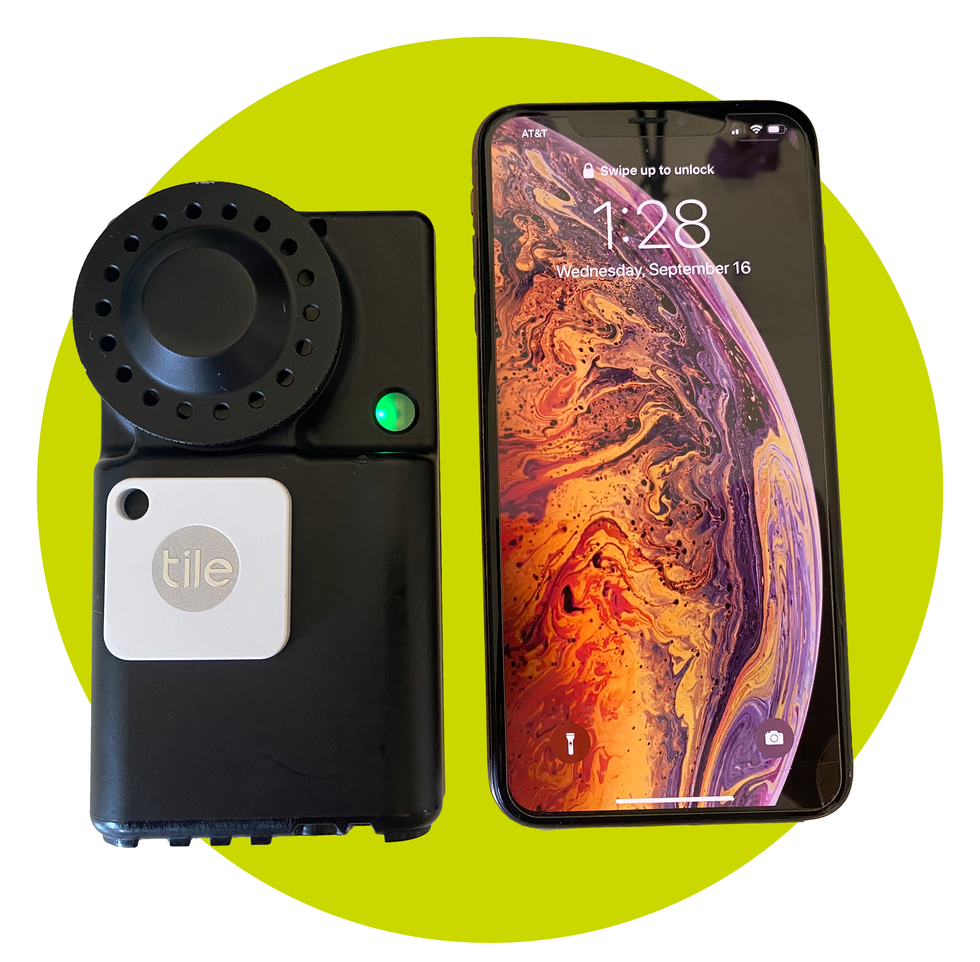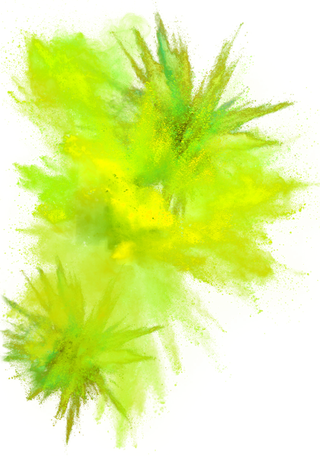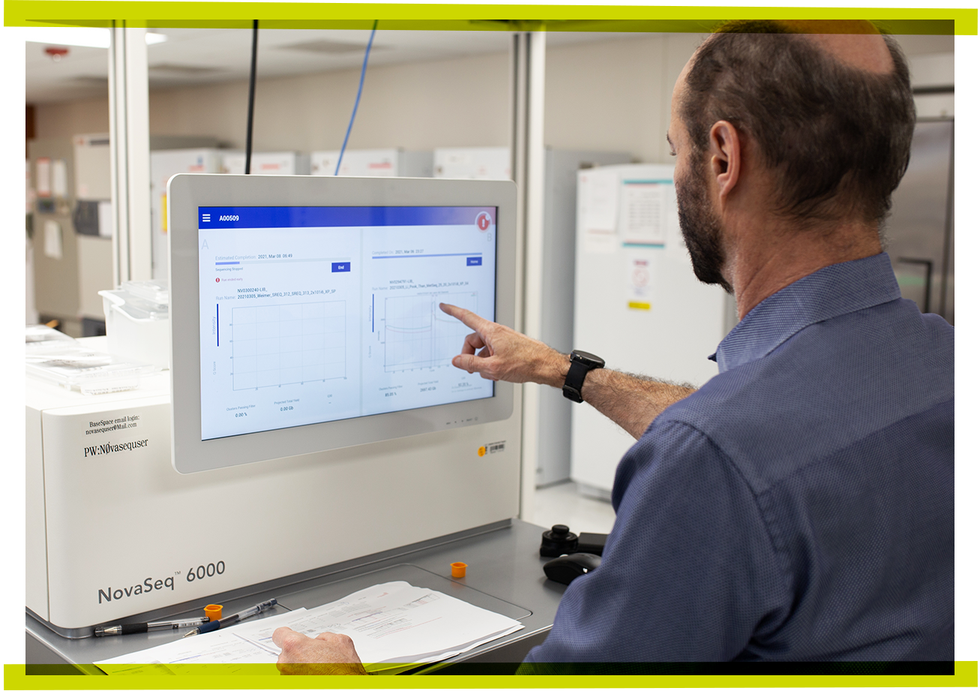Illustration by Eddie Guy
MICHAEL SNYDER, PH.D., is wearing four smart watches.
Inside his lab, the biggest on Stanford’s perennially sunny campus, the director of the Center for Genomics and Personalized Medicine pulls up a seat and walks me through his very specific everyday carry.
For nearly a decade, Snyder has been trying to quantify human health. And although he has hundreds of volunteers in six different trials, he is his own best subject. His four different smartwatches spill out nine years’ worth of heart-rate and skin-temperature data; a continuous glucose monitor graphs the effects that diet and exercise have on his blood sugar; an Oura ring tracks his sleep quality; and a black walkie-talkie-sized box he calls an exposometer “breathes” the same air as him and identifies all the airborne particles and chemicals he’s exposed to in a day. (Not in the office today are his radiation monitor, a pulse oximeter, a camera that automatically takes photos of his environment every five minutes, and his smart cycling shorts, which were a bit of a bust.) Add all this to his semiannual MRIs, the microbiome and genome sequencing, and the hormone measurements and Snyder has more than 2 million gigabytes of his own health data stored. It is distinctly possible that Michael Snyder has more data on Michael Snyder than anyone has had on any human who has ever lived.
Snyder is a geneticist, renowned for helping to create revolutionary ways to analyze the genetic blueprint that makes up a life. For as long as humans have lived and died, we’ve been trying to explain why people get sick. Hippocrates blamed an imbalance of the biles, blood, and phlegm; medieval doctors chalked illness up to man’s sinful ways. And for a generation now, since scientists first began to unravel our DNA, we’ve been primed to think that disease is written into our genes.
But these days, Snyder is taking a more holistic view of health. The smartwatches and the exposometer and the blood work and the MRIs—today, Snyder is a walking, breathing experiment, a one-man case study of how everything besides your genes can affect your health. “For the very first time, we’re discerning how your external environment, as you breathe it, influences your insides.”
How, in other words, your environment is making you sick.
Genetics is a critical part of human health. For years now, it has been the 800-pound gorilla in the research world and in our minds. And yet there’s a reason, two decades after the Human Genome Project was famously completed, you don’t have your genes sequenced at your annual wellness checkup. That’s because cardiovascular disease, cancers, diabetes, neurodegenerative disease—none of these are primarily driven by your genes. In fact, your genes account for only about 10 percent of disease development and progression.
Most of our maladies appear, instead, to be brought on by things humankind has inflicted upon itself, like lifestyle factors (diet and exercise) and what scientists call environmental factors: exposure to air and water pollution, toxic waste, and chemicals such as pesticides. “Think about a plant,” says Konstantinos Lazaridis, M.D., the executive director of the Center for Individualized Medicine at the Mayo Clinic. A plant’s growth and health don’t rely solely on the DNA in its seed. Where you plant it, the soil and its contaminants, the fertilizer you spread, the pesticides and chemicals and pollution your plant is exposed to—all these factors affect your plant’s life. “I truly believe humans are not different: We’re organic and we’re exposed to millions of things,” Dr. Lazaridis says.
But if we’re plants, then our garden is pretty messed up. A 2021 study at the University of California, San Francisco found 109 different industrial and consumer chemicals in its subjects’ blood. They ranged from plasticizers used for packaging to per- and polyfluoroalkyl sub-stances (PFAS) used in nonstick cook ware to pesticides and flame retardants. More than 50 of the chemicals had never been seen in people before; 42 were “mystery chemicals,” compounds of unknown origin. The study underscores an unsettling reality: Over the span of a generation or two, human beings have become petri dishes, our bodies unplanned experiments in which chemicals and substances that never existed in nature can interact in ways we’re only beginning to comprehend. “I once had a doctor tell me, ‘When I started my practice, all my patients were normal,’ ” a coauthor of the UCSF study, professor Tracey Woodruff, Ph.D., says.“ ‘But it’s slowly shifted to all abnormal cases. Now it’s weird to have a normal case.’ “
Everything from ballooning cancer rates for people under 50 to a crisis in sperm quality and fertility has been tied to our environmental exposures. Untangling the fallout will take years. And in the interim, more than 12 million people will die each year—a quarter of all global deaths—thanks to our toxic exposures.
It’s a good thing, then, that after ignoring these environmental factors for decades, scientists now have a name for the totality of such exposures, for your own personal accumulation: the exposome. “The exposome is the concept that nearly all exposures, even from the time in utero, will have an impact on us,” says Dr. Lazaridis. The study of your exposome— exposomics—is a whole new way to think about looking after our health. It’s an invitation for us to stop and take stock of all the crap that goes into our bodies. And it’s a chance for scientists like Michael Snyder to reevaluate the causes of disease. There’s just one problem: In a world of forever chemicals and refineries and synthetic flavors and smells, where do you even begin teasing out what affects us and how?
SEEING INSIDE YOUR BODY
In Snyder’s office, he digs into the data from his collection of smart devices. He shows me blood-oxygen data from 2015, which allowed him to detect and treat a Lyme-disease infection before symptoms appeared, then heart-rate data from one of his smartwatches, which helped detect the Lyme as well as predict a Covid infection before he tested positive. Snyder is both broad and trim, with the thick, dark beard that often comes with a bald head. He was a runner, but when data from his frequent blood tests revealed he was pre-diabetic, he switched to weightlifting, based on the hypothesis that “muscle mass is better for glucose regulation—perhaps.” He’s been lifting for six years, and today the cephalic vein that snakes down his surprisingly yoked 67-year-old biceps pops beneath his polo.
I ask him to show me his exposometer, the small wearable—around the same size as a smartphone—that his team developed and built in-house to track all of the chemicals and airborne particles its wearer is exposed to and that has brought his data-collection obsession to exposomics. “What’s special about our exposometer is it’s personal exposure,” he says. “It’s yours.”
Toxicologists have long known that many man-made chemicals and environmental toxins like lead cause disease and other adverse health effects. Anyone who watches the news has likely heard stories of industrial toxins like benzene causing leukemia or seen class-action lawsuit commercials for patients who developed mesothelioma after asbestos exposure.
Unlike these substances, however, almost none of the 80,000 other potentially toxic chemicals that are currently in use in the U. S. are closely monitored by the EPA. And most people have no idea what they’ve been exposed to in a day. That’s where Snyder’s exposometer comes in. Chemicals, bacteria, pollutants, and fungi are all sucked up by the device and then brought back to his lab for DNA sequencing and chemical profiling. So far, he’s captured traces of around 3,000 chemicals he’s come in contact with. Of that bunch, his team has been able to identify 158, including 67 that are most likely dangerous to our health.About a third are pesticides, 21 percent come from pharmaceuticals and personal-care products, 11 percent come from plastic, and an additional 10 percent or so are probably carcinogens. It’s going to be awhile until there’s a clear catalog of which exposures, and how much of each one, cause which health problems, but there are things you can do to protect yourself in the meantime.
And in a wild “n of 1” trial—a study of one subject, in this case Snyder himself (of course)—the team found real-time correlations between these external exposures and Snyder’s inner workings. Certain chemicals from plastics were associated with inflammatory markers and changes in the population of his gut microbiome; other pesticides correlated with inflammatory effects involving his kidney and liver functions.
It’s a tantalizing, thrilling step toward a future in which a Star Trek–like tricorder could tell us what ails you. But right now Snyder’s exposometer can only show current exposures, the ones his machine breathes, too. To build “a library of your exposures”—the lead in your childhood home’s water supply, the pollution from the refinery you used to live near—and tease out your full history, something exposomics researchers dream of, we need to know your past exposures.
And for that, we need something you’ve probably lost or discarded: your baby teeth.
YOUR EXPOSURE TIME CAPSULE
Humans have found or created more than 150 million chemicals. (The periodic table of elements you memorized 20 years ago? Yeah, there are now 118 entrants.) And if you think there is some regulator or safety board between you and Big Chemical’s brand-new brainchild, think again: Although the government has the power to block chemicals before they reach the market, in practice it rarely does. (The EPA has banned only 13 chemicals—ever.)
We’ve already unlocked evidence that chemicals not intended to be in the body can harm it. Dr. Lazaridis, the MayoClinic honcho and an expert on chronic liver disease, spent years looking for the genetic mutation that was thought to cause primary sclerosing cholangitis, a rare liver disorder. Then, five years ago, he decided to examine his patients’ blood for exposures. Within months, he found a correlation between the disease and a pesticide banned in the U. S. but still found on imported fruits. Exposomics researchers think we’re on the brink of finding new correlations. The ability to see what you’re exposed to right now is developing; we just don’t know how to read all your data yet. The question is whether we can figure it all out in time to save ourselves.
Manish Arora’s response to this problem is to collect baby teeth.
Arora, a Ph.D. who is a professor of environmental medicine and public health at the Icahn School of Medicine at Mount Sinai, has a unique background for a chemist turned epidemiologist: He’s a trained dentist. One day, Arora saw a felled tree and it struck him (not literally). Teeth, like trees, have growth rings. Whatever is in your bloodstream gets deposited in those rings. Read the rings, like any outdoorsman reads a tree ring, and you get a visualization of a person’s chemical exposures over time.“Like a biological hard drive,” Arora says,“archived in chronological order.” When he examined baby teeth from Flint, Michigan, he immediately found the “growth rings” from when they were exposed to lead-contaminated water. (It’s a lot easier to get people to donate baby teeth than adult teeth.) “Pesticides, nutrients—we can pick up daily inflammation markers from before you were born, and we can put a time stamp on it.” He won’t call it this, but Arora has built himself somewhat of an exposure time machine.
Exposures affect the body in myriad ways, as Snyder has already shown. They can change the bacteria in your gut, upending your microbiome. They can alter the way your cells talk to one another, throw-ing off biological function.They can impair your nervous system or put your body into a state of stress or disrupt your hormones or cause inflammation. And they can interact with your genes. In Flint, about99,000 people were exposed to lead, but only about half of households reported that their children were unwell.
Those who were worse off from lead poisoning may have been predisposed to suffer due to a number of different factors, their bodies primed for something to come in and mess up the place. And lead—the exposure—set the ball in motion.“Genetics loads the gun,” as former NIH director Francis Collins, M.D., Ph.D., puts it,“and environment pulls the trigger.” The question, then, for the rest of us is: How do we keep the safety on?
THE GREAT CLEANUP
In Utrecht a college town in the Netherlands, a new neighborhood underdevelopment is betting that it has some solutions. The Dutch are big on exposomics, so when Utrecht wanted to turn a rail-way yard into a residential neighborhood, it called Roel Vermeulen, a professor atUtrecht University and the leader of a nation-wide exposome research group. The goal for this new neighborhood was, on its face, absurd—developers said they wanted to make every resident live five years longer in good health.
Vermeulen was game. Seven million people worldwide die from air pollution each year—the most obvious of exposures. And only about 30 percent of people develop chronic illnesses based purely on their genetics, he figured, so designing this neighborhood with the exposome in mind could indeed extend people’s health span. In Vermeulen’s neighborhood, changing the environment means having a better transport infrastructure so people can walk and bike daily while breathing fewer emissions. It also means having a big community garden right in the middle of a central park that’s designed to increase activity and boost opportunities to socialize. “Your options to change genes are very limited,” Vermeulen says. “But the environment is a lot easier to change.”
It’s a lesson we could all take to heart.
It doesn’t have to be hard—or super expensive—to limit the amount of toxic chemicals you’re exposed to. “People, when they talk exposures, they think about like an explosion of the nuclear reactor at Chernobyl,” Dr. Lazaridis says. “But it’s not the catastrophic experience—it’s the stuff we’re exposed to every day that we don’t even know about.” The little exposures add up—Snyder’s exposometer shows that very clearly. And although chemicals come at you from many angles, his wearable also reveals that subtracting them, even in small ways, matters when it comes to cleaning up your body.
Michael Snyder wants to rapidly and dramatically expand the kind of fact-finding he’s doing. His exposometer isn’t quite ready for mass production yet; an app on your smartwatch won’t alert you to your exposures this year. But if you become your own exposometer—stop and evaluate what you put in or on your body every day—you can find opportunities to make small changes that make a difference, often to more bodies than yours.If you forgo spray odor eliminators, you and your toddler won’t inhale potentially harmful synthetic scents; if you skip dry cleaning, the person who works at the cleaners may be exposed to fewer cancerous solvents; if you opt out of waterproof-ing your boots, your whole community may have fewer PFAS in the water supply.
So many of the major challenges we face, like war and climate change, can seem intractable and out of our hands. But we have agency over what we intentionally put in and around our bodies. Take what we know now and start putting yourself in charge of your body’s destiny.
This story appears in the March 2023 issue of Men’s Health.

David Ferry is a reporter in Los Angeles who has written for publications including Outside, Wired, and The Atlantic.












Comments are closed.